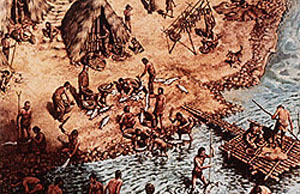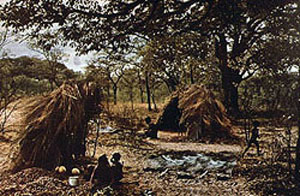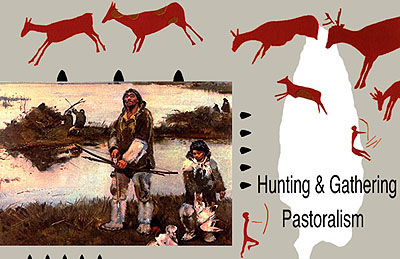Questions to consider:
- What are the differences between hunting and gathering and agriculture as modes of life? What is pastoralism?
- Consider the interactions of sedentary agriculturists with pastoral nomads. What are the possibilities for interaction? How would each group tend to view itself in contrast to the other?
 By 12,000 years ago at the latest, human populations had spread into most of the habitable regions of the globe, including Australia and North and South America. With the aid of their flexible, rapidly evolving cultures, these groups, loosely organized as small bands of "hunter-gatherers," were able to adapt to virtually all the climate zones and environmental niches on the planet, from the Arctic (above left) to temperate zones (immediately above) to the tropics (below).
By 12,000 years ago at the latest, human populations had spread into most of the habitable regions of the globe, including Australia and North and South America. With the aid of their flexible, rapidly evolving cultures, these groups, loosely organized as small bands of "hunter-gatherers," were able to adapt to virtually all the climate zones and environmental niches on the planet, from the Arctic (above left) to temperate zones (immediately above) to the tropics (below).
 The essence of hunting and gathering economies is to exploit many resources lightly rather than to depend heavily on only a few. Small, mobile human populations subsist on whatever resources are available within their territory. They adapt to conditions as they find them, using what is already there. They hunt game--whatever kinds are available, adapting their life style to the conditions they face. In temperate and tropic zones, hunter-gathers exploit many different plant resources for food, fiber, medicine, soap substitutes, etc. It is not unusual for such groups to recognize and exploit several hundred plant species. In the Arctic and sub-Arctic, hunter gatherers are forced by the climate to rely more on hunting to survive.
The essence of hunting and gathering economies is to exploit many resources lightly rather than to depend heavily on only a few. Small, mobile human populations subsist on whatever resources are available within their territory. They adapt to conditions as they find them, using what is already there. They hunt game--whatever kinds are available, adapting their life style to the conditions they face. In temperate and tropic zones, hunter-gathers exploit many different plant resources for food, fiber, medicine, soap substitutes, etc. It is not unusual for such groups to recognize and exploit several hundred plant species. In the Arctic and sub-Arctic, hunter gatherers are forced by the climate to rely more on hunting to survive.
Typically, hunter gatherers move seasonally to optimize different sources of food as they become available. A fairly large range is required for this mode of life, but human use of this kind and on this scale has relatively little impact on the environment.


 By 12,000 years ago at the latest, human populations had spread into most of the habitable regions of the globe, including Australia and North and South America. With the aid of their flexible, rapidly evolving cultures, these groups, loosely organized as small bands of "hunter-gatherers," were able to adapt to virtually all the climate zones and environmental niches on the planet, from the Arctic (above left) to temperate zones (immediately above) to the tropics (below).
By 12,000 years ago at the latest, human populations had spread into most of the habitable regions of the globe, including Australia and North and South America. With the aid of their flexible, rapidly evolving cultures, these groups, loosely organized as small bands of "hunter-gatherers," were able to adapt to virtually all the climate zones and environmental niches on the planet, from the Arctic (above left) to temperate zones (immediately above) to the tropics (below). The essence of hunting and gathering economies is to exploit many resources lightly rather than to depend heavily on only a few. Small, mobile human populations subsist on whatever resources are available within their territory. They adapt to conditions as they find them, using what is already there. They hunt game--whatever kinds are available, adapting their life style to the conditions they face. In temperate and tropic zones, hunter-gathers exploit many different plant resources for food, fiber, medicine, soap substitutes, etc. It is not unusual for such groups to recognize and exploit several hundred plant species. In the Arctic and sub-Arctic, hunter gatherers are forced by the climate to rely more on hunting to survive.
The essence of hunting and gathering economies is to exploit many resources lightly rather than to depend heavily on only a few. Small, mobile human populations subsist on whatever resources are available within their territory. They adapt to conditions as they find them, using what is already there. They hunt game--whatever kinds are available, adapting their life style to the conditions they face. In temperate and tropic zones, hunter-gathers exploit many different plant resources for food, fiber, medicine, soap substitutes, etc. It is not unusual for such groups to recognize and exploit several hundred plant species. In the Arctic and sub-Arctic, hunter gatherers are forced by the climate to rely more on hunting to survive.